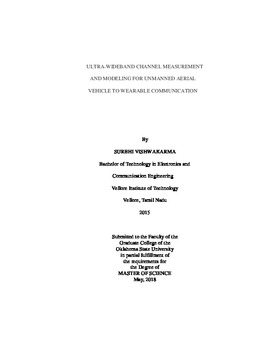| dc.contributor.advisor | Ekin, Sabit | |
| dc.contributor.author | Vishwakarma, Surbhi | |
| dc.date.accessioned | 2019-05-08T18:36:50Z | |
| dc.date.available | 2019-05-08T18:36:50Z | |
| dc.date.issued | 2018-05-01 | |
| dc.identifier.uri | https://hdl.handle.net/11244/319622 | |
| dc.description.abstract | Ultra-Wideband (UWB) has impacted our lives in impressive ways, it is one of the high potential areas with enormous benefits, especially for the short-range communication. With more discoveries, technology changed and the importance of wideband network was favored over narrowband. Officially, in the year 1933, Armstrong found and recognized the advantages of wideband signaling. Later, UWB was coined and took a fast pace and changed the conduct of the society in many ways. The most significant part about UWB is its applications, one of the claims i.e., Off-body is thoroughly studied and analyzed throughout the thesis. | |
| dc.description.abstract | We performed one of the first vertical link channel studies with Off-body channel characterization with one UWB antenna patch on Unmanned Aerial Vehicle (UAV) and another antenna at different body locations on a real human subject for the frequency bandwidth of 3.1-10.6 GHz in different environments such as anechoic, indoor, and outdoor. The main purpose is to monitor how UWB system is affected by both large and small-scale fading, that's why it was worth taking measurements in all three settings for the analysis. Also, it was critical to pick one best distributions among Lognormal, Rayleigh, Nakagami, Normal, Weibull, Gamma, Exponential and Rician using Akaike Information Criteria (AIC). The path loss varies in different environments, and its exponent becomes important parameter to be determined for all three settings. | |
| dc.description.abstract | It was interesting to study how UWB characteristics varied with different environments. The delay profiles such as power delay profile (PDP), root mean square (RMS), maximum excess and mean excess delays were analyzed. For all the analysis, we used two small, light weighted compatible antenna patches, which supported UWB bandwidth and consumed less power so that it could be safely attached to a human body. | |
| dc.description.abstract | Our work is mainly focused on the detailed understanding of standard UWB path loss and delay spreads for the communication channel between UAV and wearable. We believe this study would help us in understanding UWB Off body characteristics thoroughly and would also help in health monitoring and improvising the optimum location of the human body tag. | |
| dc.format | application/pdf | |
| dc.language | en_US | |
| dc.rights | Copyright is held by the author who has granted the Oklahoma State University Library the non-exclusive right to share this material in its institutional repository. Contact Digital Library Services at lib-dls@okstate.edu or 405-744-9161 for the permission policy on the use, reproduction or distribution of this material. | |
| dc.title | Ultra-Wideband Channel Measurement and Modeling for Unmanned Aerial Vehicle to Wearable Device | |
| dc.contributor.committeeMember | Bunting, Charles F. | |
| dc.contributor.committeeMember | West, James C. | |
| osu.filename | Vishwakarma_okstate_0664M_15765.pdf | |
| osu.accesstype | Open Access | |
| dc.description.department | Electrical Engineering | |
| dc.type.genre | Thesis | |
| dc.type.material | Text | |
